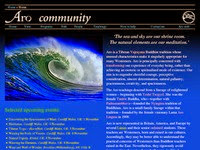 Buddhism is a statement of our intrinsic goodness; and the possibility of discovering
that intrinsic goodness. This is the simple answer, but complex questions can
arise from that. Giving a simple answer is not always that simple. When I use
the word goodness, I am not using it in the sense of nicey-nicey goodness, or
piety, or sanctity, or holiness – ‘goodness’ here relates to complete value.
This goodness is the goodness of freshly baked bread; the goodness of seeing a
field of sunflowers; the goodness of birth and death; the goodness of being
present. There is a basic goodness, a basic sanity with which we can connect.
We have that – we simply need to allow ourselves the non-referential space to
find it.
Buddhism is a statement of our intrinsic goodness; and the possibility of discovering
that intrinsic goodness. This is the simple answer, but complex questions can
arise from that. Giving a simple answer is not always that simple. When I use
the word goodness, I am not using it in the sense of nicey-nicey goodness, or
piety, or sanctity, or holiness – ‘goodness’ here relates to complete value.
This goodness is the goodness of freshly baked bread; the goodness of seeing a
field of sunflowers; the goodness of birth and death; the goodness of being
present. There is a basic goodness, a basic sanity with which we can connect.
We have that – we simply need to allow ourselves the non-referential space to
find it.Aro Encyclopaedia Index: Ah, but I was so much older then – I'm younger than that now. Ngak'chang Rinpoche interview 1993






 Through the development of spaciousness, our patterning can become totally open and transparent. We can view perception. We can recognise intention. We can motivate responses.
Through the development of spaciousness, our patterning can become totally open and transparent. We can view perception. We can recognise intention. We can motivate responses. The relationship between teacher and student is fundamental to Vajrayana.
The relationship between teacher and student is fundamental to Vajrayana.


